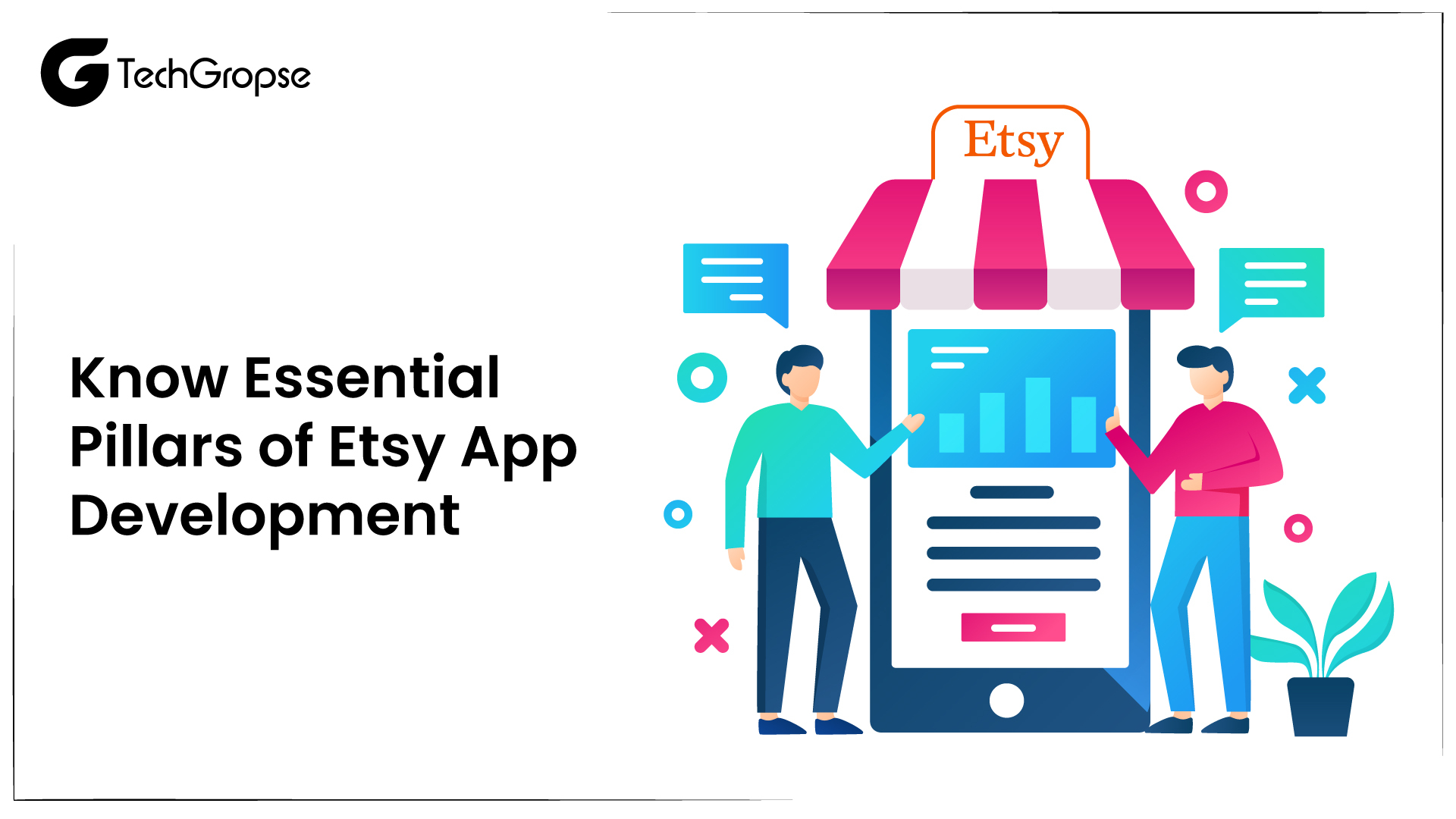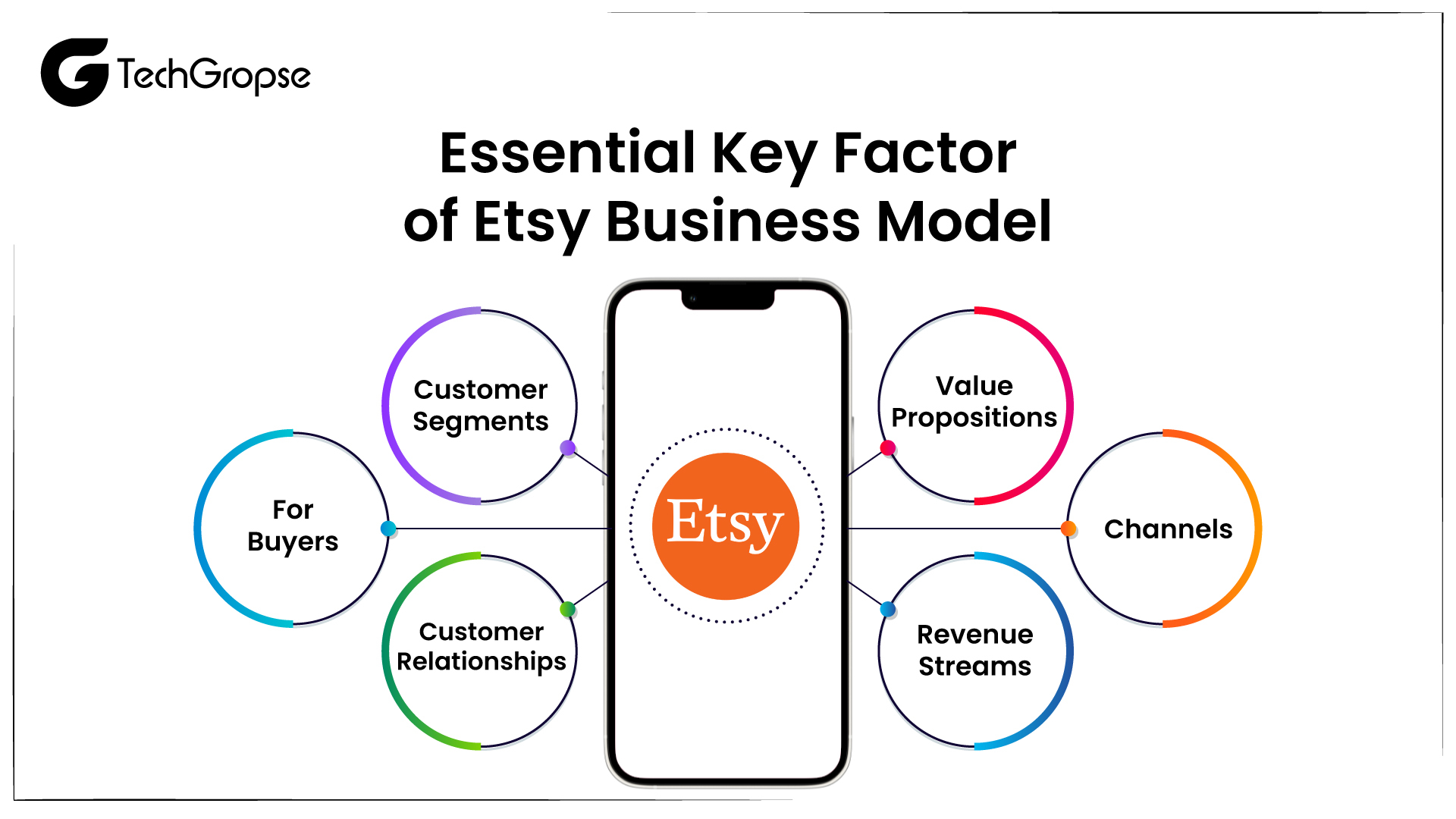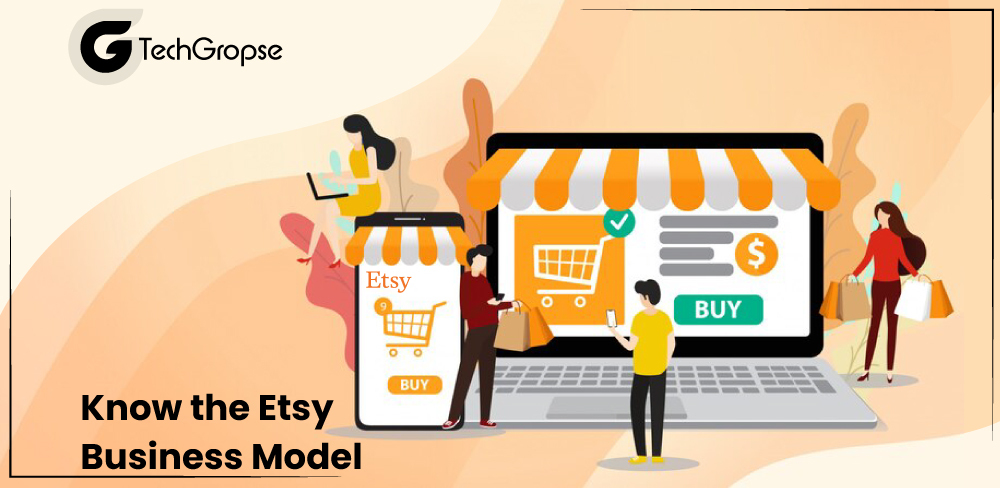Have you ever wondered where you can find amazing antique things that have been made with lots of care and skill? Like, things that are totally unique and no one else has? Know interesting things about Etsy business model? Well, let us introduce you to Etsy.
Etsy is a renowned online marketplace that has become synonymous with all things vintage, handmade, and unique. With millions of active buyers and sellers worldwide, Etsy has transformed the way artisans and crafters show their creations and connect with a global audience.
The platform’s global reach allows sellers from different parts of the world to reach a vast audience of potential buyers, making it a truly international marketplace. As a result, Etsy has played a crucial role in supporting independent artisans and small businesses, providing them with the opportunity to turn their passions into profitable ventures.
Here, we will discuss the factors that contribute to seller success on Etsy, the challenges and opportunities the platform faces in the market, and the shopping app development company for this beloved online marketplace.
What is Etsy?
If you have ever found yourself scrolling through an endless rabbit hole of adorable handmade crafts, vintage jewels, and unique items, chances are you were on Etsy.
Etsy is an online marketplace that connects creative individuals and small businesses with buyers who appreciate craftsmanship and one-of-a-kind finds. It’s like a virtual arts and crafts fair that never closes.
Well, the name “Etsy” is derived from “etsi,” a word from Italian dialects, meaning “oh yes.” It reflects the founders’ desire to celebrate uniqueness and creativity, encouraging users to say “oh yes” to the products that resonate with them.
E-commerce app development company designed Etsy which is known as a go-to destination for individuals seeking unique and customized products, vintage treasures, and a connection to a vibrant community of creative entrepreneurs.
With its focus on craftsmanship, creativity, and personalization, Etsy continues to be a beloved platform for both buyers and sellers who appreciate the value of handmade and distinct products.
History and Background of Etsy
Before knowing about Etsy business model, you should be aware of its purpose and background. Etsy was born in June 2005 when founder Rob Kalin, an entrepreneur with a passion for woodworking, wanted to make a custom shopping app development that would bring together artisans and buyers from around the world. With a focus on supporting small-scale creators, Etsy quickly gained popularity and has since grown into a global marketplace with millions of active buyers and sellers.
Originally, Etsy was envisioned as an online platform called “iospace,” which aimed to connect artists with buyers. From its humble beginnings, Etsy quickly achieved popularity within the creative community and started attracting sellers and buyers from around the world.
The Vision of the Etsy Application
“The vision of Etsy is to create a meaningful and lasting impact by empowering creative entrepreneurs and small businesses to thrive. The company believes in the power of human creativity and aims to support individuals who create unique, handcrafted, and artistic products.”
Etsy’s vision is built on several key principles:
- Community and Connection: Etsy fosters a sense of community and connection between sellers and buyers. The platform encourages sellers to share their stories, processes, and inspirations, allowing buyers to connect with the people behind the products.
- Sustainability and Ethical Practices: Etsy promotes sustainable and ethical practices, emphasizing the value of handmade and environmentally conscious products. By supporting artisans and small businesses, Etsy contributes to a more sustainable and responsible consumer culture.
- Empowering Creativity: Etsy believes that creativity should be accessible to all and seeks to empower individuals to turn their passions and hobbies into viable businesses.
- Diversity and Inclusivity: Etsy celebrates diversity and inclusivity in its community. The platform welcomes sellers from various backgrounds, cultures, and skill sets, creating a diverse marketplace that celebrates unique perspectives and talents.
- Global Impact: Etsy’s vision extends beyond providing a marketplace for buying and selling. The company aims to create a positive impact on local economies and communities by supporting independent businesses and preserving traditional crafts.
Through its vision, Etsy has transformed the way people approach ecommerce app development, offering an alternative to mass-produced and generic products. It has become a platform where creativity, craftsmanship, and personal connections converge, making it a beloved marketplace for both buyers seeking unique products and sellers pursuing their creative passions.
Facts and Stats of Etsy: Funding and Major Milestones
Do you want to make money on Etsy? Well, Etsy has this group of sellers who have the most extraordinary things for sale. They put their listings on Etsy and it’s like they have magic powers because their products can be seen by lots and lots of people through different marketing channels.
In 2021, Etsy made over $2.3 billion in money from all the things people bought. Can you believe it? There are 88.3 million people who love shopping on Etsy, and 5.3 million people who sell their stuff there too.
Funding
| Year | Funding Round | Amount Raised | Major Milestone |
| 2005 | Seed Round | $1.275 million | Etsy founded and launched |
| 2008 | Series C | $27 million | Significant growth; expanding seller and buyer base |
| 2012 | Series F | $40 million | International expansion; localized versions launched |
| 2015 | Initial Public Offering | $267 million | Etsy goes public on Nasdaq |
| 2020 | Follow-on Public Offering | $1.4 billion | Continued growth and expansion |
Milestone
| Year | Major Milestone |
| 2005 | Etsy officially launched |
| 2007 | Reached one million registered users |
| 2010 | International expansion; launched localized versions in multiple countries |
| 2013 | Committed to becoming a Certified B Corporation |
| 2014 | Reached 30 million registered users |
| 2015 | Became a publicly traded company (IPO) |
| 2019 | Acquired Reverb, an online marketplace for musical instruments |
| 2020 | Experienced significant growth during the COVID-19 pandemic |
Know Essential Pillars of Etsy App Development

Mobile app development company follow these impact pillars reflect Etsy’s broader mission to create a positive impact beyond just being an e-commerce platform. The company strives to be a force empowering creative entrepreneurs, for good, supporting communities, and leading by example in environmentally responsible business practices.
1. Economic Impact
Etsy aims to support creative entrepreneurs and artisans by providing them with opportunities for financial security and personal empowerment. In 2020, Etsy sellers made a significant contribution to the U.S. economy.
Their collective efforts amounted to a total of $13 billion, indicating the economic significance of the creative community on the platform. Additionally, Etsy played a role in creating 2.6 million jobs in the independent worker economy, demonstrating its impact on supporting independent sellers and facilitating entrepreneurship.
2. Social Impact
Etsy believes in equitable access to opportunities, and the company is committed to supporting various communities and organizations. In 2020, Etsy invested over $2.6 million in charitable gifts to support community organizations and programs.
3. Ecological Impact
As part of its long-term resilience strategy, Etsy is focused on minimizing its environmental footprint and promoting responsible resource use. In an effort to address climate change and reduce its carbon impacts, Etsy sourced 100% of its electricity from renewable energy sources.
Inspiring Success Story of Etsy Business Model
To build shopping app successfully in the market is quite tricky. Etsy’s success story is indeed inspiring and offers valuable insights into how a company can divide a market and rule by focusing on a niche and catering to a specific audience.
Here are some key factors that contributed to Etsy’s success and make an online business model:
1. Identifying a Niche
Etsy started with a clear focus on a specific niche market – handmade and unique products, vintage items, and craft supplies. By targeting a niche that was not well-served by mainstream e-commerce platforms, Etsy was able to attract a community of artisans, crafters, and creative entrepreneurs who were looking for a platform to show and sell their products.
2. Empowering Sellers
Etsy’s approach to empowering sellers played a crucial role in its success. The platform provided sellers with the tools and resources to set up their shops, list products, and manage their businesses effectively. By giving sellers the autonomy to showcase their creativity and manage their stores, Etsy built a community of entrepreneurs who were invested in their success.
3. Curating Quality Products
Etsy focused on curating quality products and maintaining a high standard for the items listed on its platform. This approach helped build trust among buyers, knowing they could find unique and well-crafted products on Etsy.
4. International Expansion
Etsy’s decision to expand internationally by launching localized versions of the platform in various countries further fueled its growth. By reaching a global audience, Etsy was able to connect sellers with buyers from different parts of the world, expanding the market reach and diversity of products available.
5. Embracing Technology
While focusing on handmade and vintage items, Etsy also embraced technology to create a seamless and user-friendly online shopping experience. The platform introduced features like Etsy Payments, personalized recommendations, and mobile apps, keeping up with evolving customer expectations.
6. Continuous Innovation
Etsy’s success can also be attributed to its ability to innovate and adapt to changing market dynamics. The company continuously introduced new features, services, and improvements based on user feedback and market trends.
Essential Key Factor of Etsy Business Model

Etsy’s business model can be analyzed using the Business Model Canvas and you can hire dedicated developers, which is a strategic management tool that provides a visual representation of how a company creates, delivers, and captures value.
Here’s an overview of Etsy business model using the nine key components of the Business Model:
1. Customer Segments
- Etsy’s primary customer segments are buyers who are interested in unique, handmade, and vintage products, as well as craft supplies.
- Additionally, Etsy serves creative entrepreneurs, artisans, crafters, and small businesses who act as sellers on the platform.
2. Value Propositions
- For Buyers: Etsy offers a wide selection of one-of-a-kind and artisanal products, providing a unique and personalized shopping experience. It connects buyers with sellers who offer creative and high-quality products.
- For Sellers: Etsy provides a global platform for sellers to showcase and sell their handmade creations, vintage items, and craft supplies. It enables creative entrepreneurs to reach a broader audience and build their businesses.
3. Channels
- Etsy operates an online marketplace that serves as the main channel for connecting buyers and sellers. The platform is available via mobile devices and desktops.
- Sellers can set up their shops, list products, and manage their businesses through Etsy’s Seller Dashboard.
4. Customer Relationships
- Etsy fosters a sense of community and engagement among buyers and sellers. Sellers can interact with customers through messages and reviews, building relationships and trust.
- Etsy also provides customer support to address inquiries and issues.
5. Revenue Streams
- Etsy generates revenue through various streams:
- Listing Fees: Sellers pay a fee to list their products on the platform.
- Transaction Fees: Etsy charges a percentage of each sale made through the platform.
- Advertising and Promotional Tools: Sellers can pay for advertising and promotional services to boost visibility.
6. Key Resources
- The platform itself is a key resource for Etsy, as it facilitates the marketplace and connects buyers and sellers.
- Etsy’s brand, reputation, and the community it has built are also essential resources.
7. Key Activities
- Etsy’s key activities include maintaining and enhancing the online platform, managing seller and buyer interactions, and providing customer support.
- The company continuously innovates to improve the user experience and expand its services.
8. Key Partnerships
- Etsy collaborates with payment processors to facilitate secure transactions.
- It may also partner with shipping carriers to offer sellers discounted shipping rates and logistics support.
9. Cost Structure
- Etsy’s main costs include platform maintenance, customer support, marketing, and transaction processing.
- The company may also invest in technology, research, and development to enhance the platform.
Etsy Revenue Model: How Does Etsy Earn Money?
Do you know Etsy how to make money? In simple words, the Etsy business model revolves around delivering a platform for sellers to show and sell their handmade or vintage products, and craft supplies.
1. Marketplace Platform
On demand app development company built Etsy that provides an online platform where individual sellers can make their shops and list their products for sale. The platform acts as an intermediary, allowing sellers to show their items to an expansive audience of potential buyers.
2. Listing Fees
Etsy charges sellers a small fee for listing their products on the platform. This fee covers the cost of displaying the products in the search results and relevant categories.
3. Transaction Fees
Etsy charges a transaction fee on each sale made through the platform. This fee is a percentage of the total order value and applies to the item’s price, shipping costs, and any applicable taxes.
4. Advertising and Promotions
You can get different methods to make money on Etsy like advertising and promotional tools for sellers to improve visibility and reach more potential buyers. Sellers can pay for these services to boost their listings, appear in search results, and target specific audiences.
5. Etsy Payments
Etsy provides a secure payment processing system called “Etsy Payments” (formerly known as “Direct Checkout”). This service allows buyers to make purchases using various payment methods, such as debit cards, credit cards, and PayPal. Etsy may charge processing fees for each transaction conducted through Etsy Payments.
6. Etsy Plus and Etsy Premium
Etsy offers subscription plans for sellers, called Etsy Premium and Etsy Plus. These plans provide additional features like listing credits, advanced shop customization, and discounts on certain services, in exchange for a monthly fee.
7. Shipping and Delivery Services
Etsy partners with shipping carriers to offer sellers discounted shipping rates and provides tools for sellers to manage shipping and order fulfillment efficiently. Etsy may earn revenue through commissions or partnerships with these shipping providers.
8. Pattern by Etsy
Pattern is a service offered by Etsy that allows sellers to create their standalone e-commerce websites using Etsy’s infrastructure. It provides sellers with a customizable website and domain name for a monthly fee.
9. Data and Analytics
Etsy offers sellers access to data and analytics tools that provide insights into their shop’s performance, customer behavior, and other metrics. Sellers may choose to pay for more advanced analytics services.
10. Seller Services
Beyond the basic platform, Etsy may offer various seller services, such as Etsy Studio (a marketplace for craft supplies), advertising tools, and seller education programs. These services may generate additional revenue for the company.
How Does Etsy App Development Cost
The shopping app development cost of an Etsy-like app can differ significantly depending on different factors, like the app’s features, complexity, platform, design, development team rates, and location.
Additionally, the shopping app development company offers ongoing maintenance, updates, and server costs should be considered.
| Cost Component | Estimated Cost Range |
| Project Planning and Research | $2,000 – $5,000 |
| Design and User Interface (UI) | $5,000 – $15,000 |
| App Development (Frontend & Backend) | $30,000 – $100,000+ |
| User Authentication & Security | $3,000 – $10,000 |
| Payment Gateway Integration | $3,000 – $8,000 |
| Search and Filter Functionality | $5,000 – $15,000 |
| Product Listing & Shopping Cart | $10,000 – $25,000 |
| Reviews & Ratings Functionality | $5,000 – $12,000 |
| Messaging & Notifications | $5,000 – $15,000 |
| Admin Panel & Analytics | $15,000 – $30,000 |
| Testing & Quality Assurance | $5,000 – $15,000 |
| Launch & Deployment | $2,000 – $5,000 |
| Total Development Cost (approx.) | $100,000 – $250,000+ |
Final Thought
Etsy has carved its unique place in the e-commerce landscape as a haven for artisans and lovers of all things handmade. With its user-friendly interface, personal interactions, and commitment to quality, Etsy continues to attract a loyal community of buyers and sellers.
As the platform navigates challenges and explores new opportunities, its future looks bright. So whether you’re a seller looking to showcase your creativity or a buyer searching for something one-of-a-kind, Etsy is the place to be.
Happy shopping and selling!
FAQ: Know the Etsy Business Model
1. How does Etsy make money?
Etsy generates revenue through various channels. The primary sources of income include listing fees, transaction fees, and additional services like Etsy Plus. Sellers are charged a small fee for listing their products on Etsy, and when a sale occurs, Etsy takes a percentage of the transaction value.
2. Can anyone sell on Etsy?
Yes, almost anyone can sell on Etsy. The platform welcomes artisans, crafters, and vintage collectors from around the world. However, it is essential to comply with Etsy’s guidelines and policies, which include ensuring that the products listed are handmade, vintage, or craft supplies.
3. How can sellers increase their chances of success on Etsy?
Success on Etsy is influenced by several factors. Sellers can increase their chances of success by offering unique and high-quality products, investing in branding and shop presentation, utilizing effective marketing and promotion strategies, and providing excellent customer service.









